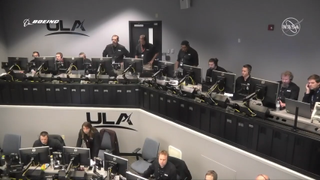Updated: CAPE CANAVERAL, Fla. — Boeing's Starliner astronaut taxi suffered an anomaly today (Dec. 20) during its flight to the International Space Station during the Orbital Flight Test (OFT) mission.
About 90 minutes after blastoff, NASA Administrator Jim Bridenstine said on Twitter that the capsule will not be able to reach the space station because it burned too much fuel during the anomaly.
The Atlas V rocket from United Launch Alliance successfully launched from Space Launch Complex 41 here at Cape Canaveral Air Force Station in Florida at 6:36 a.m. EST (1136 GMT) as planned. But, as of about an hour after launch, the mission team had announced an anomaly with the uncrewed capsule's orbit.
"Starliner in stable orbit. The burn needed for a rendezvous with the ISS did not happen. Working the issue," Bridenstine tweeted,following the announcement of the anomaly.
Related: Boeing's 1st Starliner Flight Test in Photos
Starliner in stable orbit. The burn needed for a rendezvous with the ISS did not happen. Working the issue.December 20, 2019
About 15 minutes after launch, Starliner was scheduled to complete a 40-second orbital insertion burn that would have evened out its orbit to a circle, allowing it to meet up with the space station. But this stage in the flight was off-nominal, or different from what they expected.
"We have since experienced an off-nominal insertion and the spacecraft is in a stable position," Boeing spokesperson Steve Siceloff said during a launch broadcast. "It's fully powered; mission control here in Houston is assessing all the options."
"After launching successfully at 6:36 a.m. Eastern Time Friday on the United Launch Alliance Atlas v rocket from Space Launch Complex 41 at Cape Canaveral Air Force Station in Florida, the Boeing Starliner space vehicle experienced an off-nominal insertion," Boeing spokesperson Kelly Kaplan told reporters here at the press site.
"The spacecraft is currently in safe, stable configuration," Kaplan added. "Flight controllers have completed a successful initial burn and are assessing next steps. Boeing and NASA are working together to review options for the test and mission opportunities available while the Starliner remains in orbit. A joint news conference will be held at 9 a.m. Eastern on NASA TV."

The OFT was designed as a critical milestone to test Starliner for future crewed missions. Following this procedure, Boeing plans to launch a Crewed Flight Test with three astronauts onboard Starliner.
NASA hired both Boeing and SpaceX to develop reusable vehicles capable of bringing humans safely to and from the space station. Ever since the 2011 retirement of the space shuttle, the agency has been relying on Russian Soyuz spacecraft for access to the orbiting laboratory.
Prior to today's launch, both Boeing and SpaceX were targeting crewed test flights in 2020.
This story is developing and will be updated as more information is available.
Editor's note: This story was updated at 8:35 a.m. with comments from Kaplan and 9:01 a.m. with additional comments from Bridenstine.
Follow Chelsea Gohd on Twitter @chelsea_gohd. Follow us on Twitter @Spacedotcom and on Facebook.

"space" - Google News
December 20, 2019 at 08:22PM
https://ift.tt/35Jq88W
Boeing's Starliner Won't Reach Space Station, NASA Chief Says - Space.com
"space" - Google News
https://ift.tt/2Q8TIzF
Shoes Man Tutorial
Pos News Update
Meme Update
Korean Entertainment News
Japan News Update
Bagikan Berita Ini















0 Response to "Boeing's Starliner Won't Reach Space Station, NASA Chief Says - Space.com"
Post a Comment